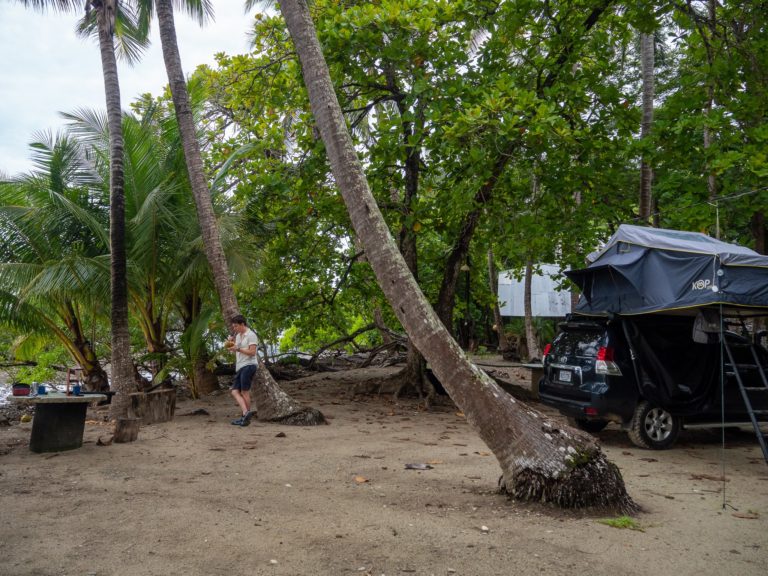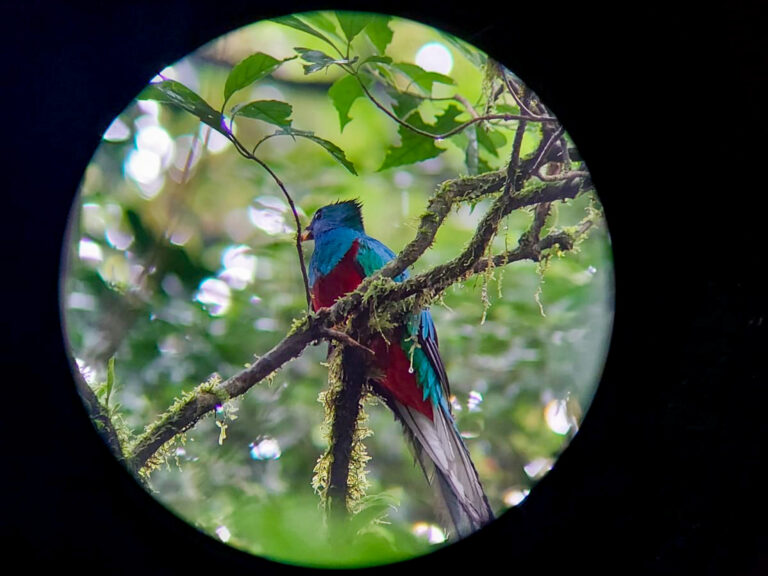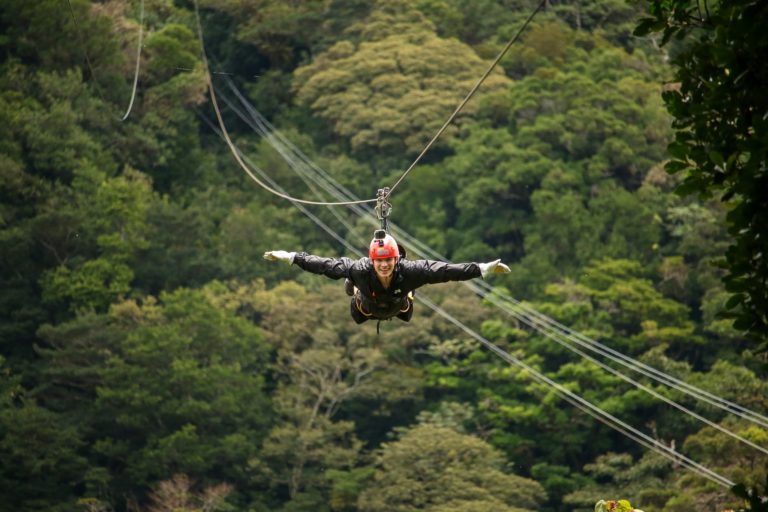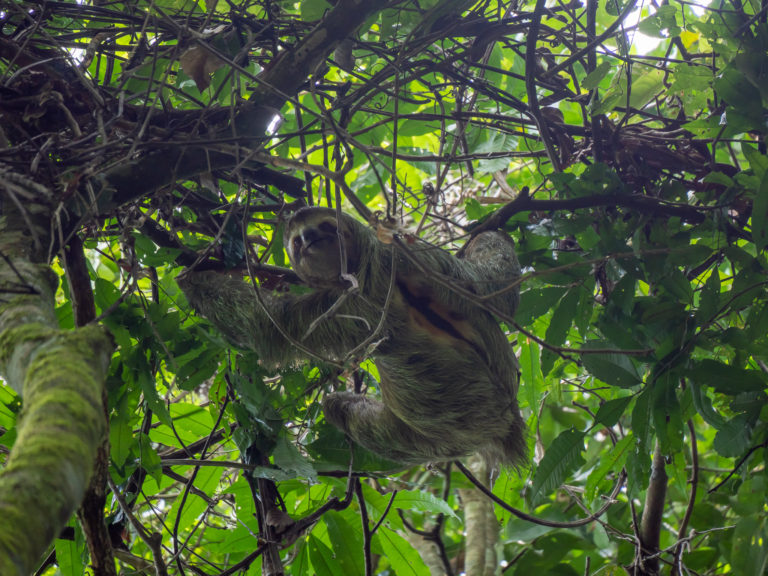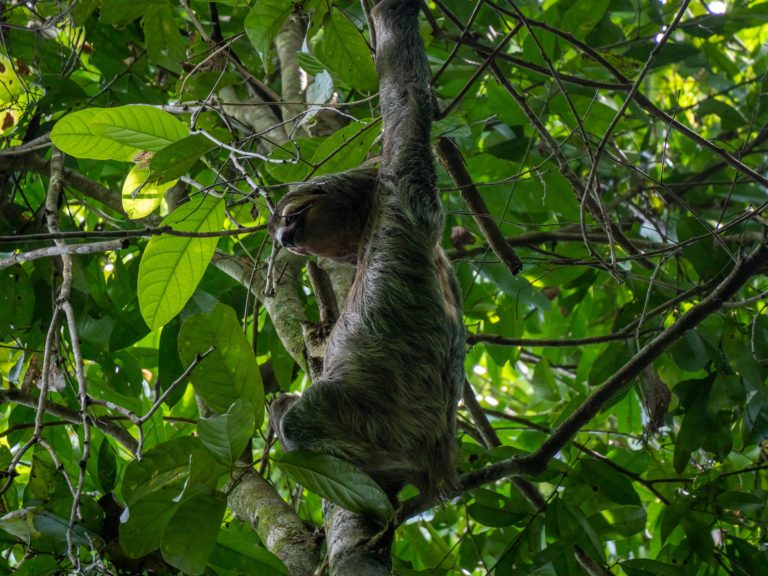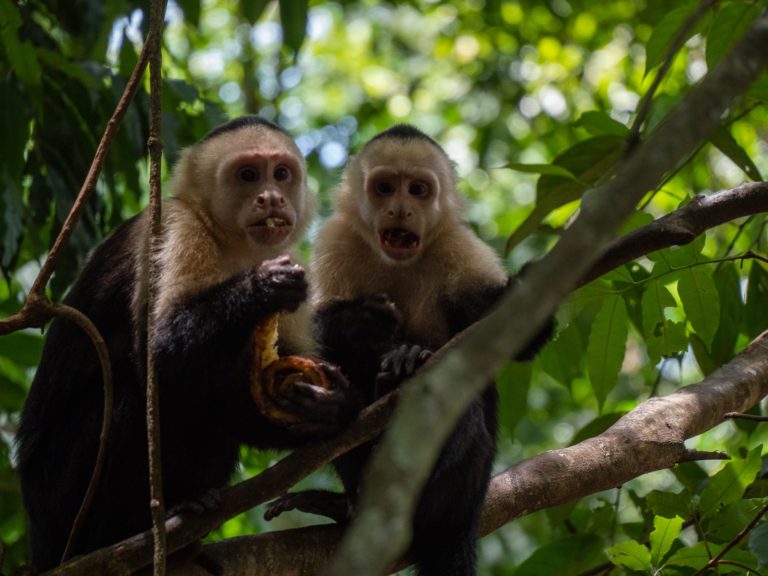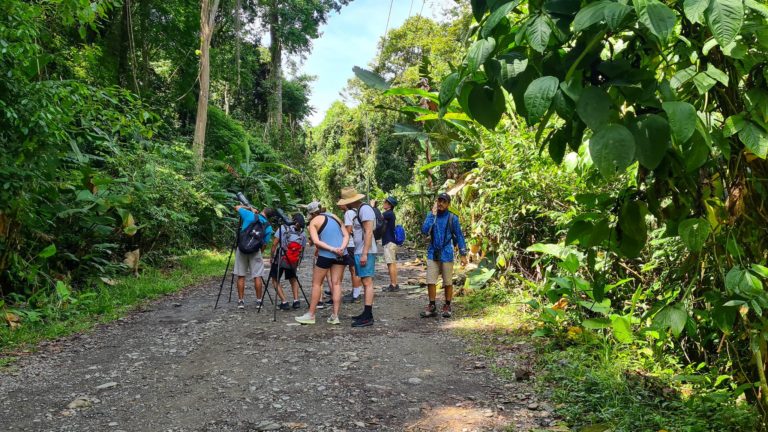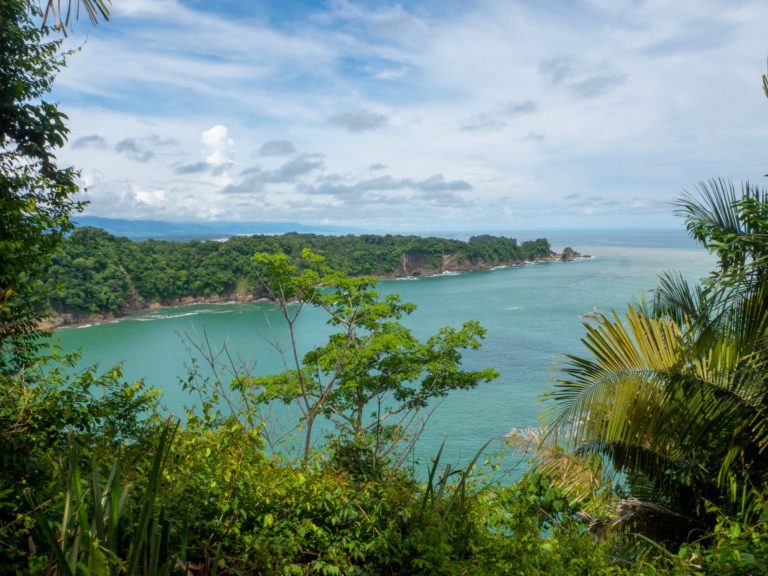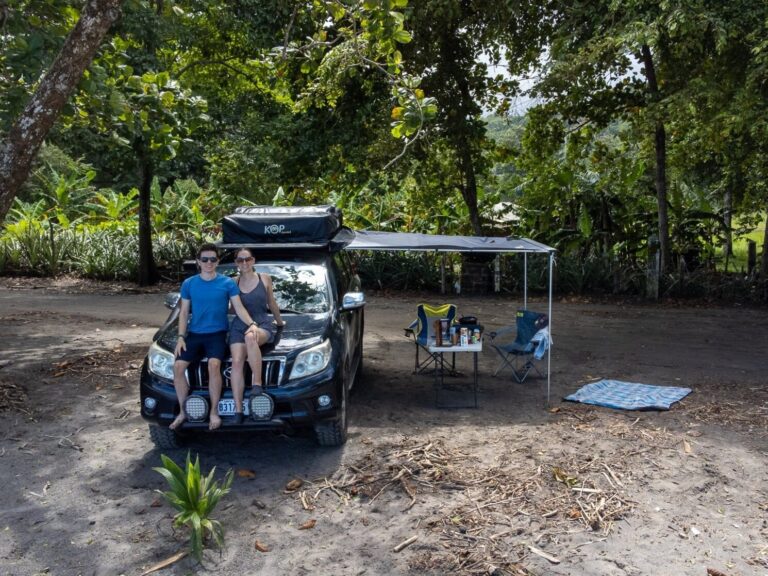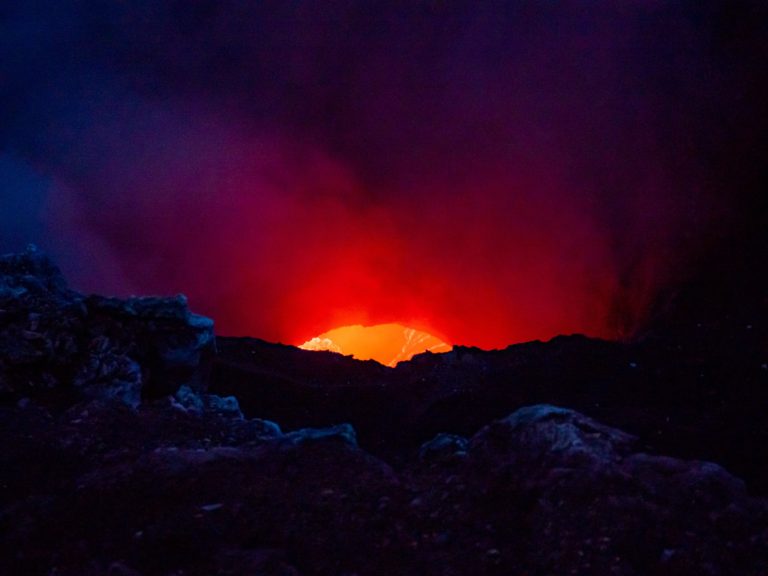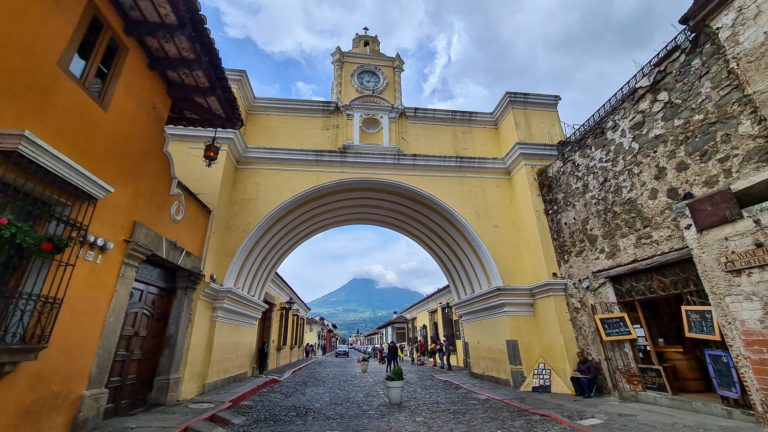Visiting Copán Mayan Archaeological Site + The Best Things to do in Copán Ruinas
A complete guide to one of the best Mayan ruins in Central America, plus the best things to do in Copán Ruinas town, and seeing Scarlet Macaws in the wild!

This post may contain affiliate links, which means we might earn a small commission on anything purchased through these links at no extra cost to you. Learn more on our disclaimer page.
Central America is home to some of the most impressive Mayan Ruins in the world and this is no more evident than in Copán, Honduras. A UNESCO World Heritage Site, Copán is one of the most well-preserved Mayan sites in Latin America, and it’s much quieter than a lot of its bigger competitors too. Although we’re big advocates of saving money and visiting Mayan ruins yourself, at Copán, we’d recommend you take a tour. There are so many intricate details with such a fascinating history that you’re bound to miss out on a lot of information if you don’t have a guide. And while you’re there, keep an eye to the sky. Honduras is also one of the best places in the world to spot scarlet macaws in the wild. Discover everything you need to know about visiting the Copán Mayan Archaeological Site, as well as the best things to do in Copán Ruinas town, in this complete Guide to Copán.
Time needed: 2-3 hours.
When to go: The best weather falls in the dry season between December-April, while the shoulder seasons of January-February and May-June offer cheaper prices.
Weather: Hot and tropical with year-round temperatures ranging between 18-28°C (65°F-82°F).
Language: Spanish, 5 indigenous languages (Garifuna, Miskito, Sumo, Pech, and Jicaque), several other languages spoken by ethnic groups and migrants.
Currency: Honduran Lempira (US Dollars are accepted).
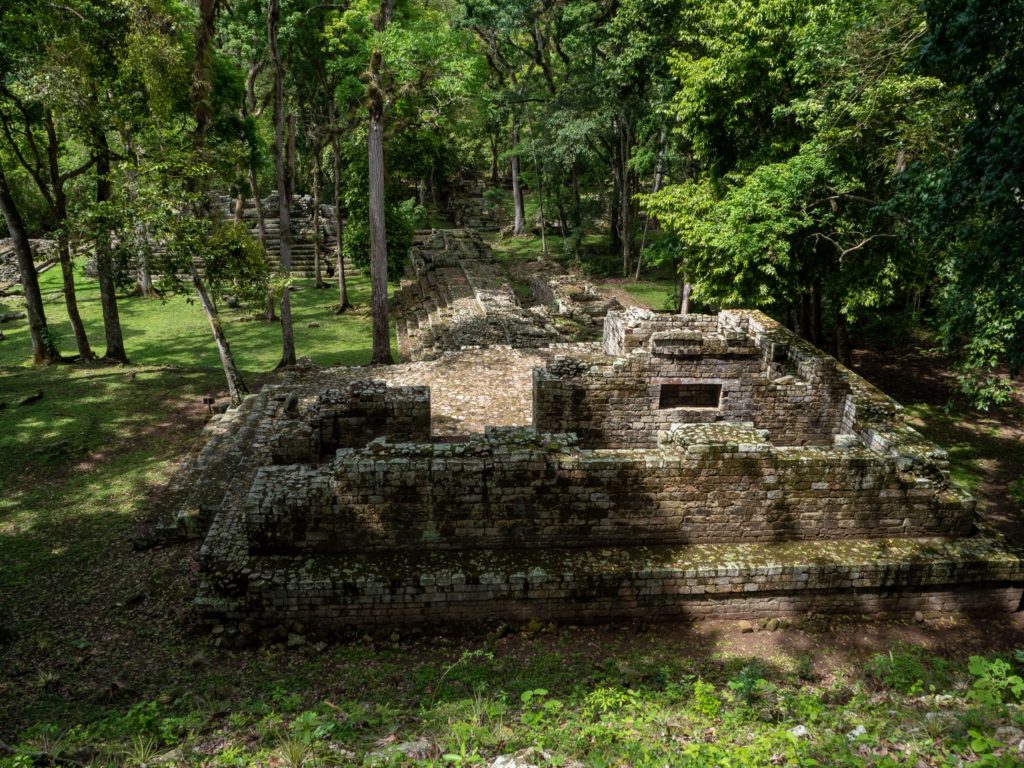
Why visit Copán?
You might be wondering if Copán is worth visiting, especially if you’ve already been to the larger Mayan sites like Chichén Itzá and Tikal. The answer is yes! A visit to Copán is totally worth it and it’s unlike any other site in Latin America.
Honduras is one of Central America’s least-visited countries and its attractions see far fewer visitors than other, more popular sites. You’ve probably heard of famous Mayan archaeological sites in Mexico like Teotihuacán, Chichén Itzá and Palenque. And, if you’re interested in Central American history, you’ll also be aware of Xunantunich in Belize and Tikal in Guatemala too. Well, Copán is not only well preserved and cheap to visit, but it is much quieter than all of these other sites too. It may not be as large as the aforementioned attractions, and its structures might not be as grand, but Copán can give you an insight into the Mayan world that no other site can.
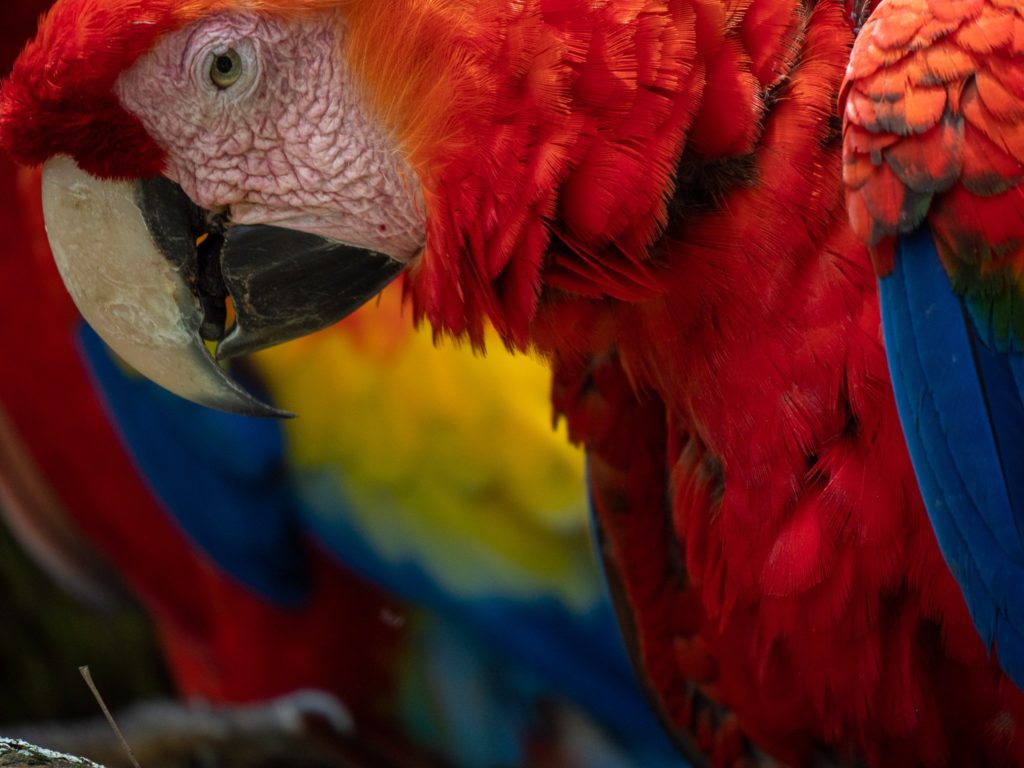
What is Copán famous for?
The globally renowned Mexican site of Chichén Itzá is often referred to as the New York of the Mayan World due to its grand structures. Its well-preserved Mayan ruins have even earned it a place on the list of New Wonders of the World. In contrast, the much smaller site at Copán is called the Paris of the Mayan World, in reference to the high quality of carvings and artistic skill still prevalent in the stone remains.
Copán is famous for its intricately carved structures, which can be found throughout the site. It is the most important cultural site in Honduras and was declared a UNESCO Archaeological World Heritage Site in 1980. The site of Copán is home to impressive temples and structures, as well as numerous carved stelae and altars and one of the largest ball courts in the Maya World. These important records of an ancient Mayan civilisation date back over a thousand years. Excavation is still ongoing at the site as it is believed a lot more has yet to be revealed.
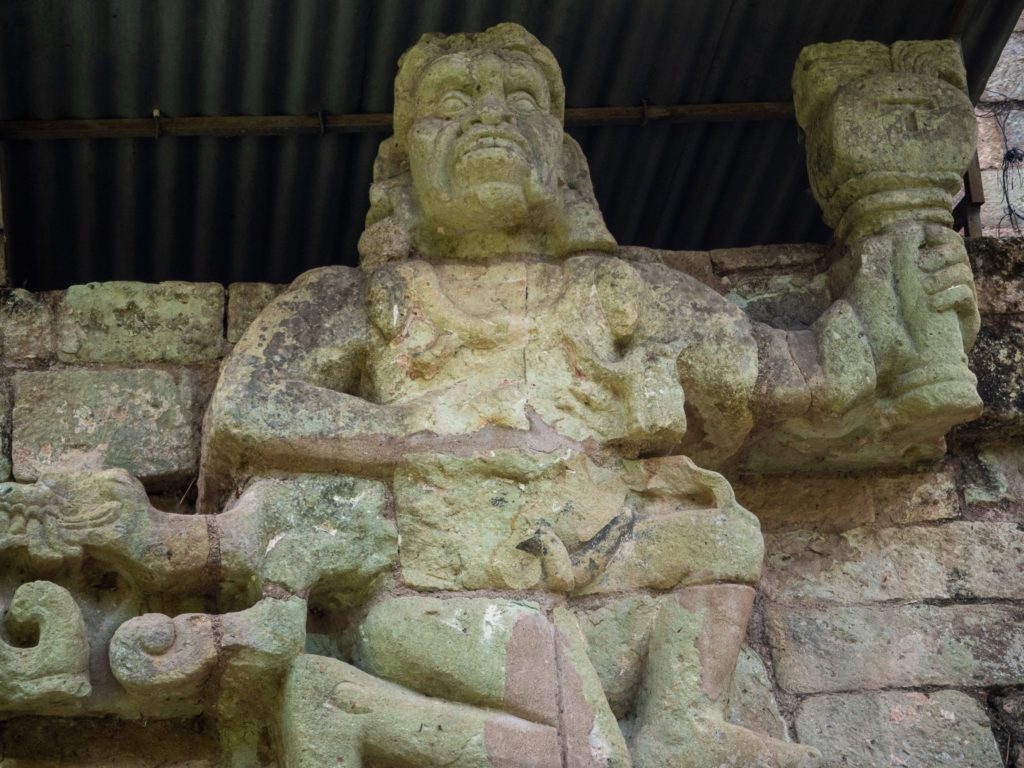
Copan’s tropical climate has preserved a large amount of the detailed carvings on the temples and structures throughout the area. One structure of note is The Plaza of the Hieroglyphic Staircase. This huge staircase sits in the middle of the site and features the 3rd largest inscription in the world. Stretching 26 metres (86 ft) from the plaza to the summit, the staircase consists of over 2,000 individual stone glyphs. The 63 steps are 10 metres wide and more than 1,250 individual glyphs have been carved into the staircase. It is by far the longest glyphic inscription in the Maya World.
Archaeologists rebuilt the staircase upon its discovery and it was later found that the stones had all been scrambled out of order! Work is ongoing to fully decipher each step so they can be returned to their original order.
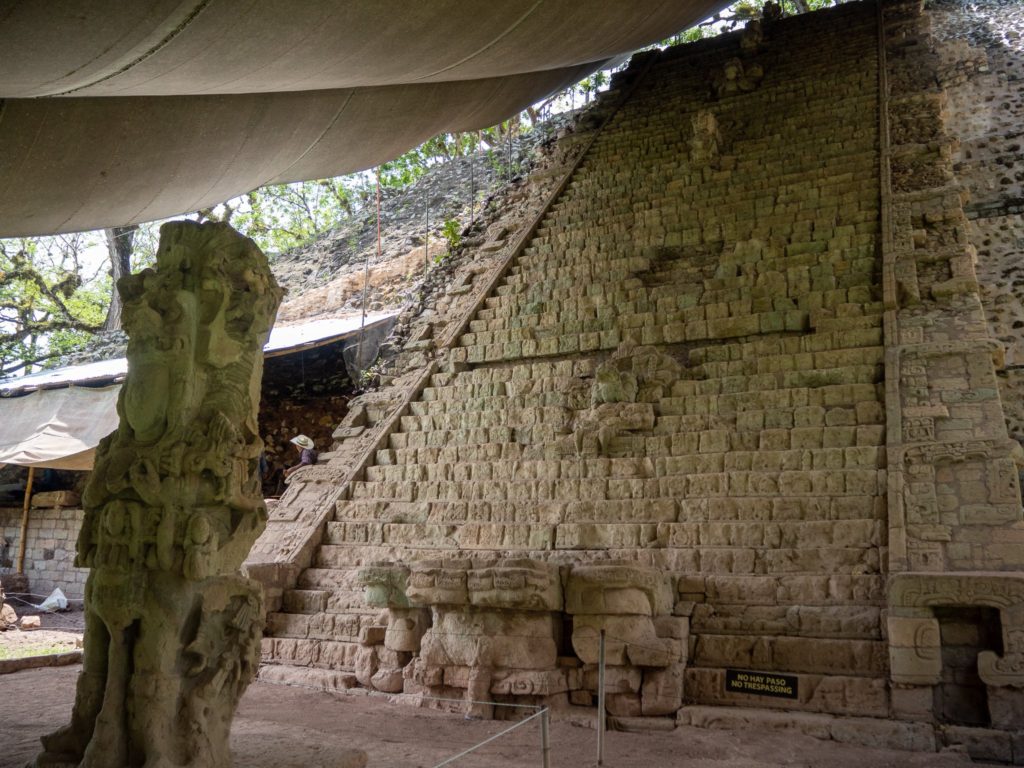
Copán’s history
Copán was once a powerful city ruling a vast kingdom. It is believed that, at the peak of its power in the Late Classic period (600-900 A.D.), Copán covered an area about a quarter of the size of the city of Tikal. It’s thought that the city had a population of at least 20,000 people with only 6000-9000 of them living in central Copán. Evidence of population in the Copán Valley dates back to 1500 B.C, but the city is thought to have been built in the Classic Period of 200-600 A.D.
Copán’s dynasty saw 17 rulers. The first, Yax Kuk Mo, came from the area of Tikal (Petén) in 427 A.D. The city grew and major cultural developments took place with significant achievements in mathematics, astronomy and hieroglyphic writing. The city suffered a catastrophic disaster in 738 A.D. when Uaxaclajuun Ub’aah K’awiil, one of the greatest kings in Copán’s dynastic history, was captured and beheaded by his former vassal, the king of Quiriguá. The unexpected defeat resulted in a 17-year hiatus as the city struggled and records fell quiet.
Within a few decades, Copán’s rulers began to build monumental structures again, although populations began to decline. Over the following centuries, the site experienced the same collapse as other Mayan sites across the continent. The last recorded ruler was Ukit Took who ascended to the throne in 822 A.D. and, in the 10th century, the site was abandoned completely.
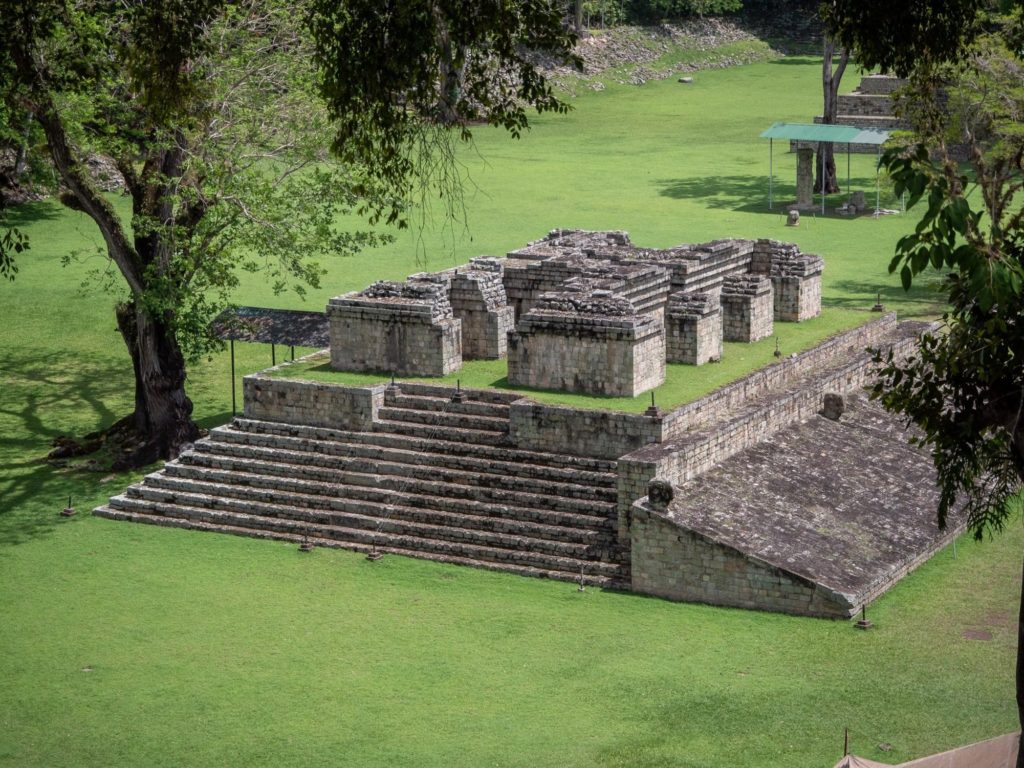
Copán Archaeological Site opening times
The site is open between 08:00-16:00 each day. We’d recommend entering as soon as the doors open at 08:00. This way you’ll be the first in and, depending on the season, you’ll likely have the site all to yourself. There is a small museum at the entrance, as well as toilets and a gift shop. As with most attractions in Latin America, guides will gather outside the entrance and offer their services. We’d highly recommend hiring a local guide who can give you more information about the Mayan civilisation that lived here.
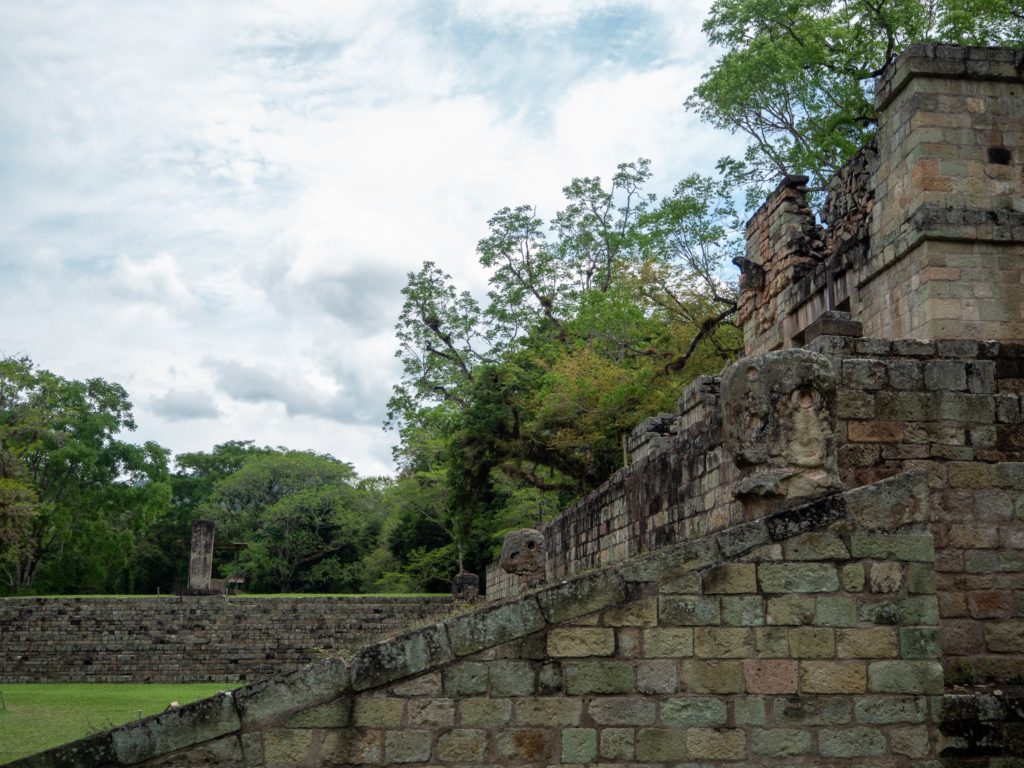
Copán Archaeological Site entry prices
The entry fee is $15, with an extra $7 for the museum and $15 for the tunnels.
When at the entrance you can negotiate a price for a tour of the site (usually between $30-$40 depending on the number of people). If you are looking for pick-up and drop-off services from your accommodation, then the price will be slightly higher.
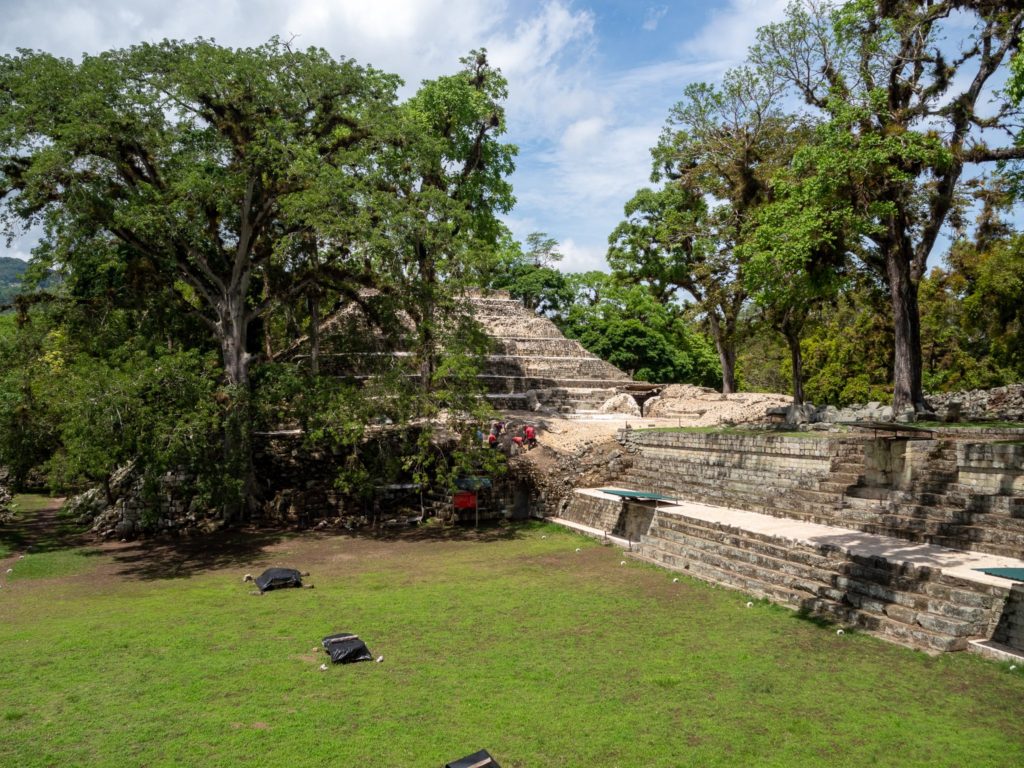
Where is Copán in Honduras?
In a remote corner of Honduras, not too far from the Guatemalan border, lie the Ruins of Copán. The site sits in a fertile mountain valley at an elevation of 600 meters (1,970 ft) above sea level. The valley the site is nestled within shares the same name, as does the nearby river. Copán River is a tributary of the mighty Motagua River. An important trade route linking the Highlands to the Gulf of Honduras, the Motagua River winds all the way through Belize to the Yucatan Peninsula in Mexico.
Confusingly, the nearest town to the Copán Mayan Ruins is also named similarly. Copán is the Mayan Ruins, while Copán Ruinas is the name of the nearby town. The town of Copán Ruinas sits only a 20-minute drive from the Guatemalan border, in the North West of Honduras. Copán Archaeological Site is less than a mile (1km) and only a 15-minute walk from the centre of Copán Ruinas Town. The town itself is small with an authentic, old-world charm and is likely where you’ll want to base yourself.
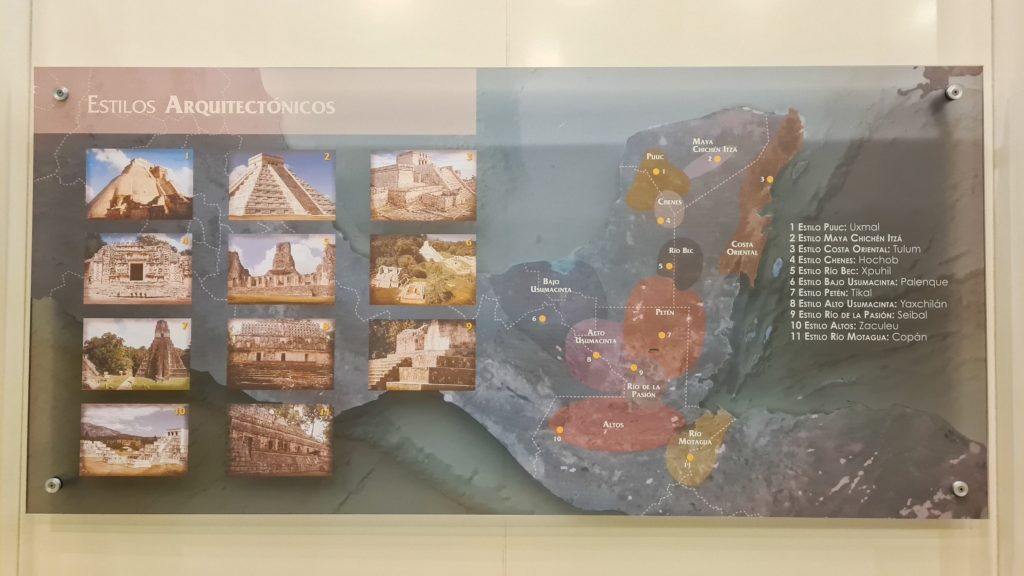
Interactive Copán Map
How to get to Copán Ruinas
From other parts of Honduras: Buses are available from San Pedro Sula or La Entrada, although San Pedro Sula especially is not considered a particularly safe destination.
From Guatemala: Travelling from Guatemala is the easiest and most popular way to get to Copán Ruinas. Tourist shuttles service the route frequently from Antigua and are quite affordable. If you want the hassle taken out of your journey, including all the faff at the border crossing, consider joining a 2 Day Tour of Copan and Quirigua from Guatemala City.
We visited Copán as part of Intrepid’s Central American Journey – a 17-day small group tour through some of Central America’s best highlights.
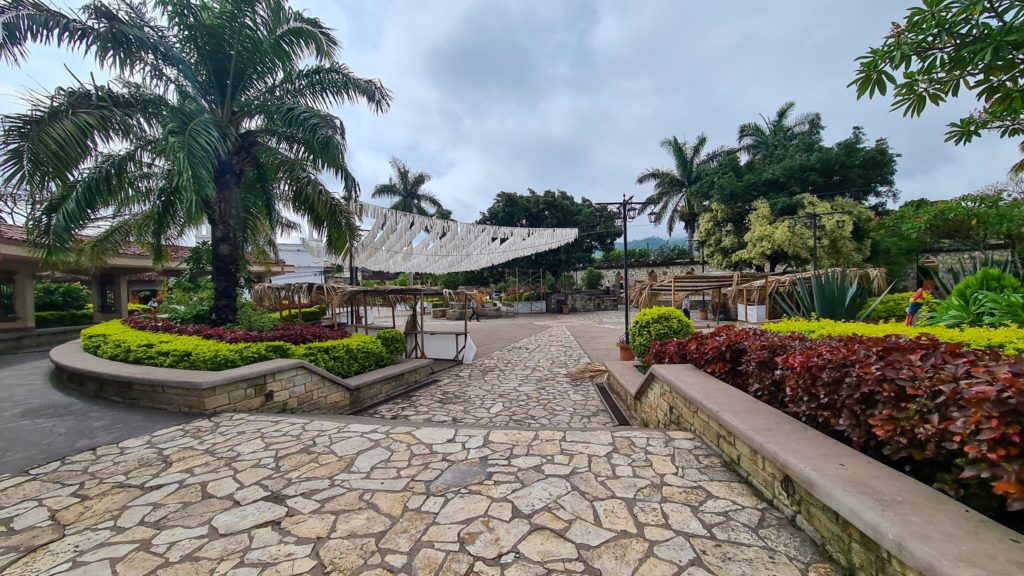
The best restaurants in Copán Ruinas
Café Welchez – A cosy, traditional coffee house located in the main square, serving traditional cuisine made with local ingredients. You can even take a Coffee Tour to learn more about the environmentally friendly methods Café Welchez uses to grow, cultivate and harvest their coffee beans.
Buena Baleada – You cannot travel to Honduras without trying a baleada. A traditional Honduran dish of tortilla stuffed with refried beans, cream, cheese and fillings of your choice, such as plantains, eggs, tomatoes and avocado.
Café ViaVia – An independent global chain, ViaVia serves international cuisine and is a great spot for vegetarians and vegans.
Pupuseria el Pijazo – Although pupusas are a dish from El Salvador, they’re eaten widely across Central America. A cornmeal or rice flatbread stuffed with cheese, beans and meat (usually pork rinds, known as chicharrón), these tasty snacks are not to be missed.
Mayan Ice Cream Rolls – A cute little café offering sweet treats like waffles and cinnamon buns and specialising in rolled-up ice cream.
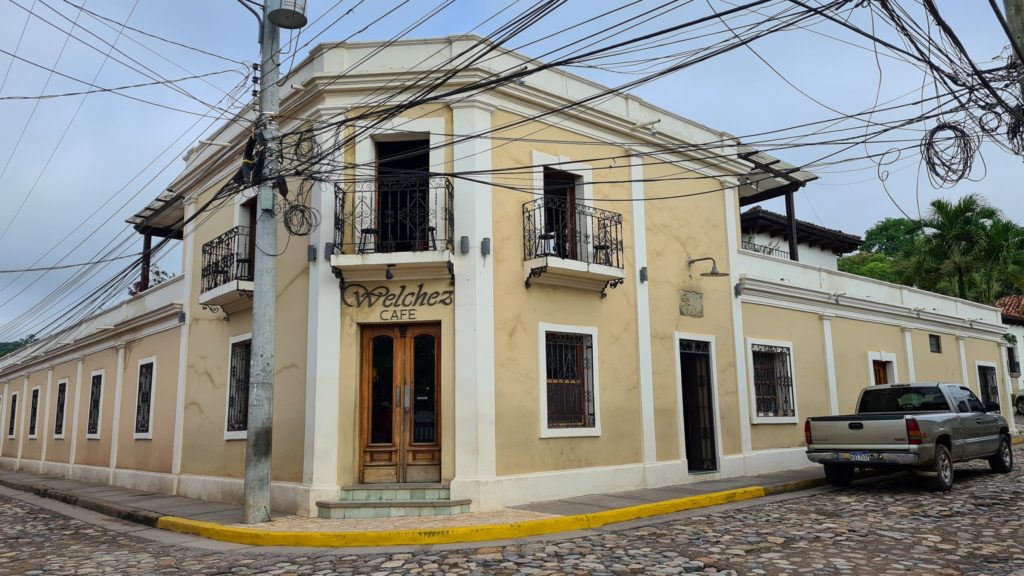
The best things to do in Copán Ruinas
Copán Ruinas may be a small town, but there are still things to see besides the Mayan ruins. The central park provides a quiet place to soak up the atmosphere and is home to a small church, Parroquia San José Obrero. A cajero BAC (ATM) can be found here too. There are three museums centred around the town square too: The Museum of Mayan Sculptures, The Digital Museum and the Archaeological Museum.
Day trips can be arranged to the Luna Jaguar Spa, an eco-spa with thermal hot pools. While The Tea & Chocolate Place provides insight into the sustainable ways of growing and harvesting cacao, as well as a terrace restaurant. If you plan to stay for a bit longer you can take Spanish classes at Copán Spanish School.
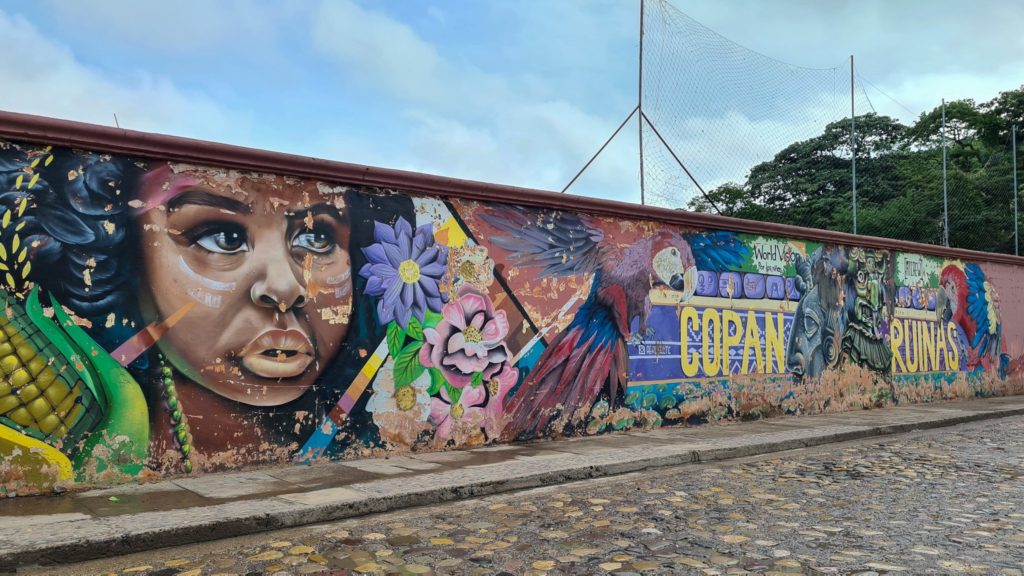
Where to see scarlet macaws in Honduras
Copán Ruinas is also home to the Macaw Mountain Bird Park, a rehabilitation and release centre for scarlet macaws. Scarlet macaws can be found all around the town of Copán Ruinas, but one of the best places to see scarlet macaws in Honduras is at the Copán Mayan Ruins Archaeological Site. You’re bound to see them fly overhead, or hang out in the surrounding trees.
On our visit, we were lucky enough to come across a pair of love birds. Scarlett macaws mate for life, raising babies together, grooming each other and flying side by side. This couple, pictured below, sat for ages preening each other and rubbing their beaks together. And seeing the national bird of Honduras is completely free! Listen out for them calling to each other, take a pair of binoculars and don’t forget a long lens for your camera!
Read next: The Best Wildlife Photography Camera Settings
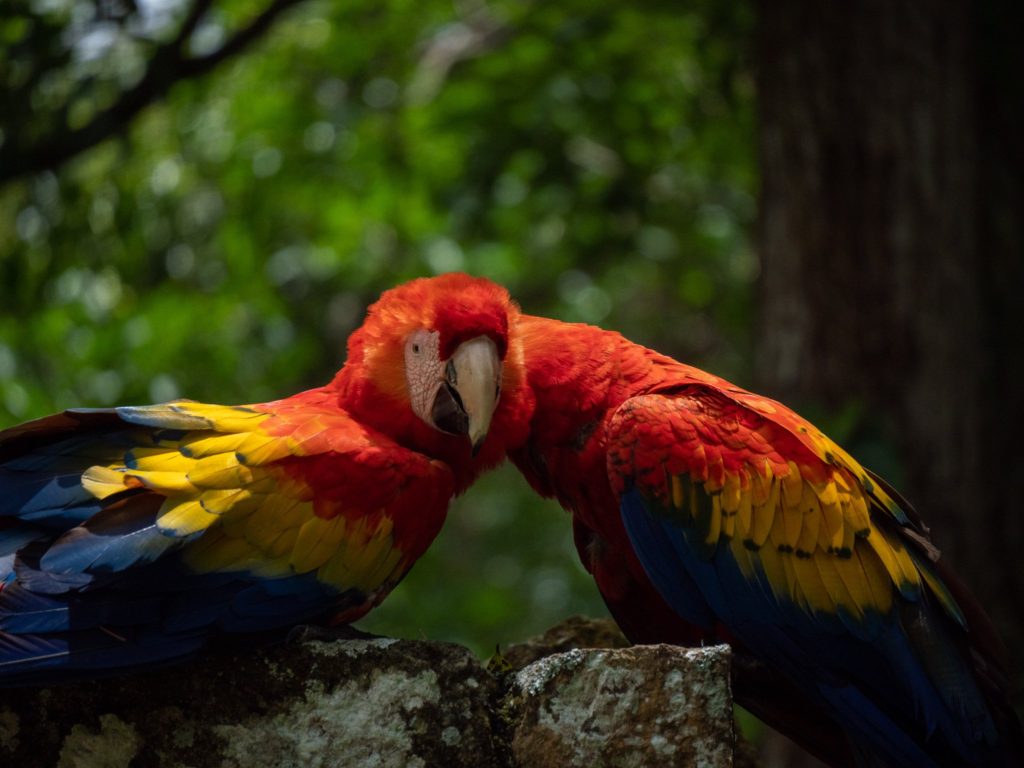
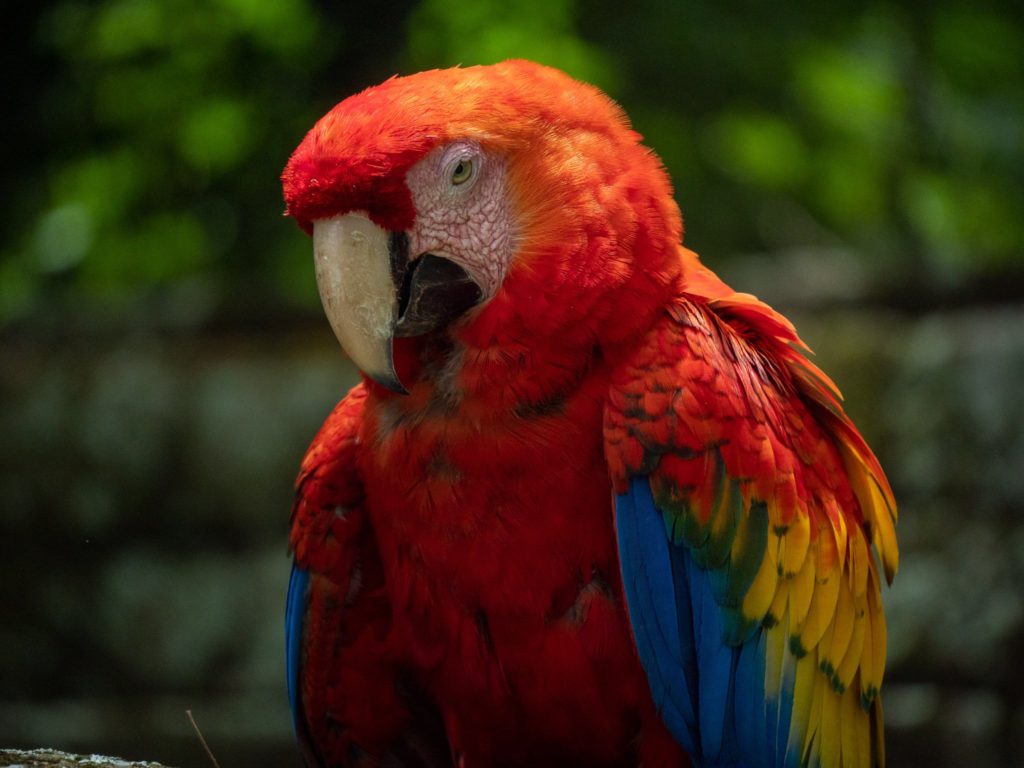
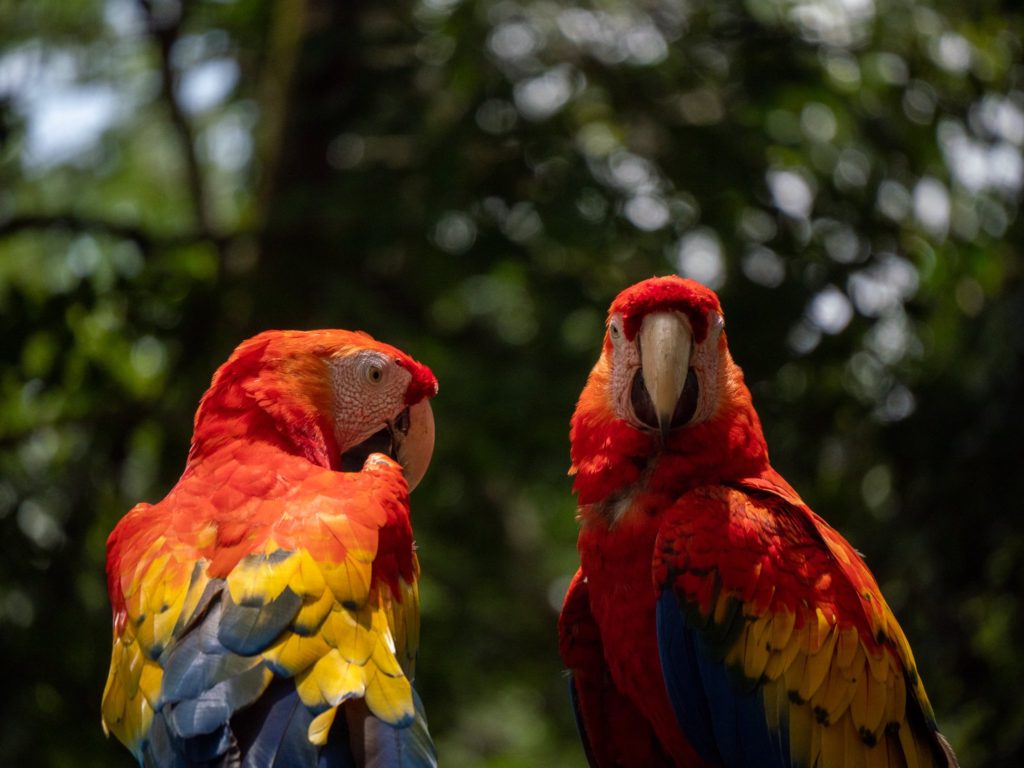
Where to stay in Copán Ruinas
There are a variety of hotels to choose from in Copán Ruinas, from budget to luxury. Here are our top picks:
Budget: Hotel Iguana Azul
Mid-range: Hotel Marina Copan
Luxury: Hotel Camino Maya Ciudad Blanca
Those on a budget will be pleased to know that Copán also has a couple of hostels to choose from too, with beds starting at $10 a night.
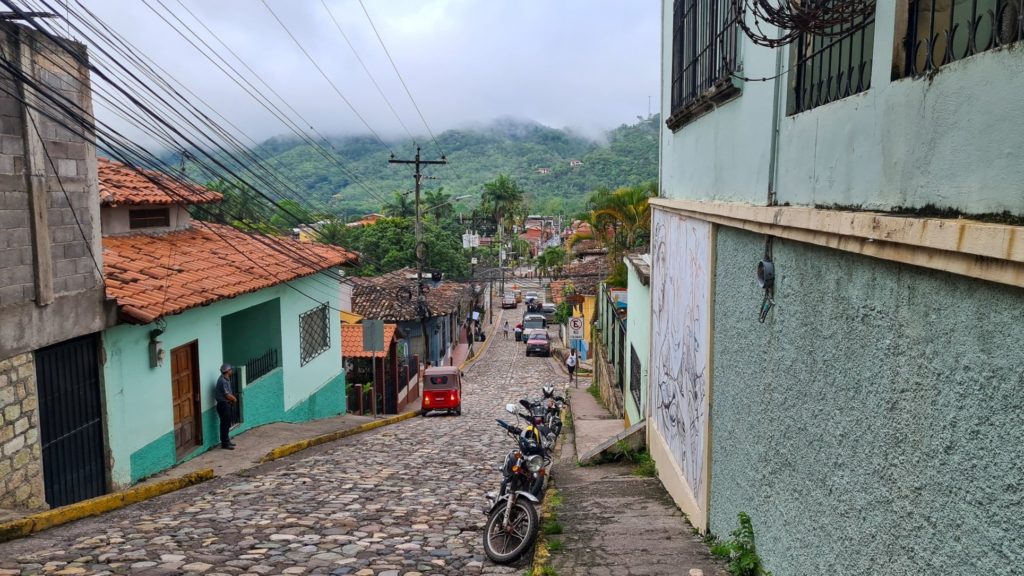
FAQs
Is Copán, Honduras Safe?
Honduras has a reputation as being a dangerous country, but this is an unfair stereotype. Like any country in Central America (and the rest of the world for that matter), there are more and less safe bits. Copán is quite safe, as is any other touristy area in Honduras. It’s wise to practice all the usual safety precautions you take when travelling, but the worst you’ll likely encounter is petty theft like pickpocketing.
Is Copán, Honduras worth visiting?
Absolutely. Copán is one of the most underrated Mayan sites in Central America. Not only are the sculptures and structures incredibly impressive, but there are virtually no other tourists around to spoil your experience too. Plus, it’s one of the best places in Honduras to see scarlet macaws.
How many days do you need to visit Copán, Honduras?
For the Mayan site itself we would recommend at least 2-3 hours. A stay in town need not exceed one night, but up to three days will give you plenty of time to settle in and get an authentic feel for the tasty food, friendly people, beautiful landscapes and exciting excursions that Honduras has to offer.
Read next:
The Thorough Guide to Uxmal: The Cheapest Way To Get To Mexico’s Mayan Ruins From Mérida
The Thorough Guide to Antigua: Guatemala’s Old Colonial Capital
Everything you need to know about Visiting Nicaragua’s Masaya Volcano National Park
Road-tripping Costa Rica in a 4×4 Camper Car with Nomad America
